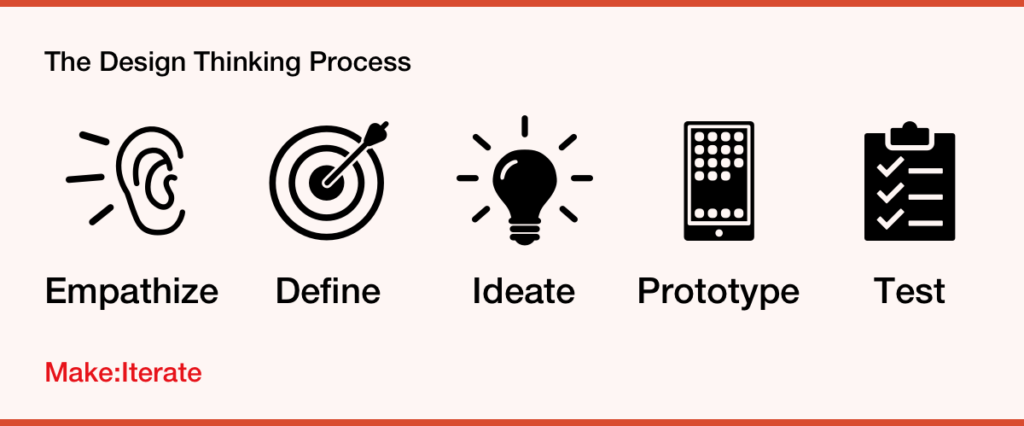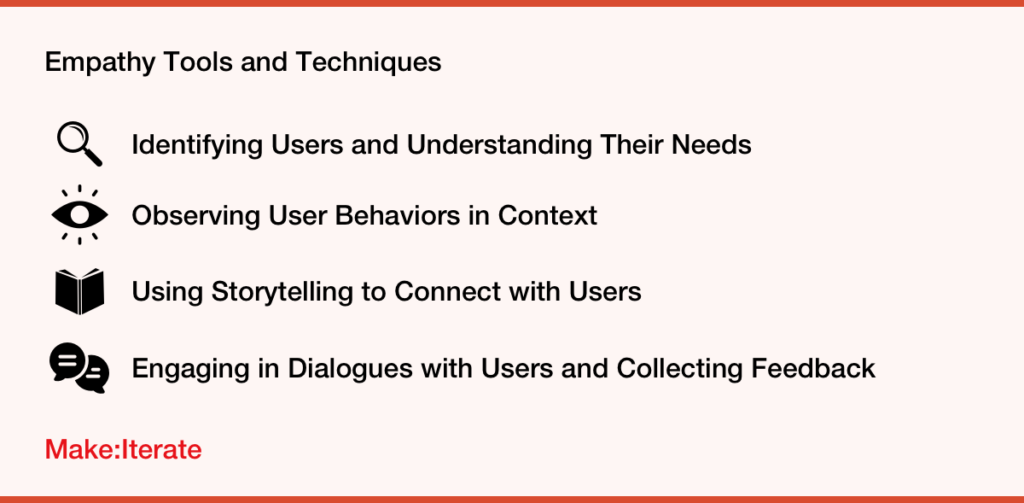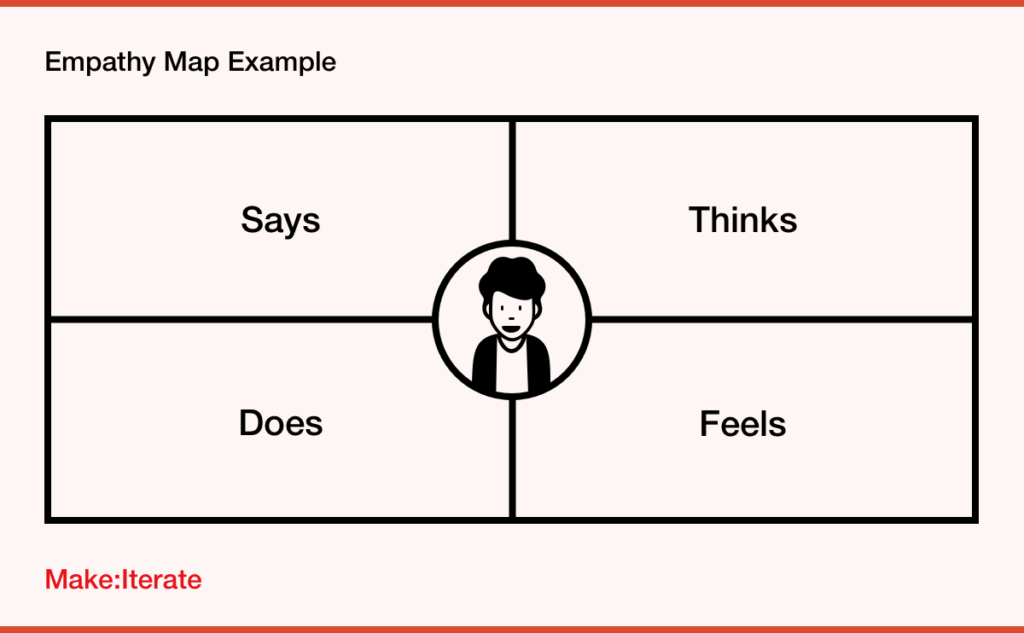Empathy is the ability to feel what another person is feeling. It’s useful in the Design Thinking process as it allows us to design experiences that closely align with actual users’ wants and needs.
This article will explore the concept of empathizing in design thinking and how this process can be used to create better user experiences.
Did you know?
To help teams implement Design Thinking, we offer bespoke innovation training workshops. Talk with us and find out how we can help transform the way you design your products and services.
Interested? Message us in the bottom right corner or learn more here.

What Is Empathy, and Why Is It Important in Design Thinking?
Empathy is the ability to understand and share the feelings of another person.
It involves putting yourself in someone else’s shoes and feeling what they are feeling.
There are three types of empathy: cognitive empathy, emotional empathy, and compassionate empathy.
Cognitive empathy is the ability to understand someone else’s perspective and thoughts. It involves seeing things from their point of view and comprehending their emotions.
Emotional empathy is the ability to feel what someone else is feeling. It involves feeling the same emotions as the other person, such as joy, sadness, or anger.
Compassionate empathy involves not only understanding and feeling the emotions of others but also wanting to help them. It involves a sense of compassion and a desire to alleviate the suffering of others.
Empathy is the ability to understand and share the feelings of another person.
Design thinking is a process for solving complex problems and creating an innovative solution.
One of the key principles of design thinking is empathy, or the ability to understand and deeply connect with the needs and emotions of the user.
This is important because it allows designers to create solutions that are tailored to the specific needs and desires of the user.

Practical Tools and Techniques for Practicing Empathy in Design Thinking
1. Identifying Users and Understanding Their Needs
To create effective solutions, designers must first identify their target customers – those who stand to benefit from the design.
This helps them focus on these users’ specific needs and desires rather than attempting a generic product that may not be relevant or useful in any meaningful way.
When designers proactively understand what potential consumers need and want, they can craft experiences designed with this user group specifically in mind; offering real value.
One of the most effective ways to understand user needs is to simply ask them.
Conducting in-depth user interviews allows designers to better understand the user’s needs, desires, and pain points.
After the empathy stage and user research has taken place, designers create UX Design artifacts like personas, user journeys, empathy maps, and storyboards.
These artifacts help design thinkers to interpret the research data into meaningful insights and get a deeper understanding of the customer journey that can be shared with the team and referred to throughout the project.
2. Observing User Behaviors in Context
Understanding user behavior in its natural environment is key to designing a successful product or service.
Through direct observation, designers can understand how users use the product and uncover their needs, pain points, and even unintended uses.
This allows for data-driven decisions tailored specifically to the user – leading to more effective products or services with higher customer satisfaction rates.
Understanding user behavior in its natural environment is key to designing a successful product or service.
To gain valuable insights into user behaviors, designers can use an array of ethnographic research methods like contextual inquiry, diary studies, user interviews, and usability testing.
Contextual inquiry involves observing and interviewing users in their natural environment while they’re performing their tasks.
Diary studies are when we ask users to keep a diary of their activities and interactions with a product or service for us to review with them later.
Interviews and usability testing involve speaking with users and asking them questions to understand more about the problem and get feedback on our potential solution.
3. Using Storytelling to Connect with Users
Storytelling is a powerful tool that can help us connect with users on a deeper level.
By crafting a compelling narrative and using storytelling techniques, we can engage users in a way that goes beyond the surface-level features and benefits of a product or service.
Co-creating stories with users about their lived experiences is a great way of encouraging the user to explore and share their own experiences.
We can then play these stories back to other customers to hear how they resonate and where their experiences may differ.
By developing stories with users, we not only get to benefit from hearing their reflections and thought processes, but we get a human centered UX Design artifact to share with our team and stakeholders.
4. Engaging in Dialogues with Users and Collecting Feedback
The number one way of getting to know your users is to simply speak with them.
It doesn’t have to be any more complicated than that.
By asking customers to reflect on their experiences and asking probing questions along the way, we can deeply understand what matters to them the most.
We can then use this information to decide what to design and how to design it.
Two main approaches for speaking with users are, structured and unstructured interviews.
The best way to get to know your users is by speaking with them directly.
Structured interviews are when you have a specific set of questions that you aim to work through with each customer.
Keeping your questions consistent allows you to collect data and compare the user’s responses.
This can be particularly useful when you need to be able to have a direct comparison or collect quantitative data.
Unstructured interviews are when you don’t follow a predetermined set of questions. You engage in open-ended discussion with the user and let the conversation flow naturally.
Most interviews are a combination of both methods. The interviewer may prepare a list of questions that acts as a guide but will also follow interesting lines of thought and conversation.
5. Observational research methods (e.g. field studies, user interviews)
Observational research is a type of research method in which researchers observe and record the behavior of people, animals, or natural phenomena in their natural environment.
Observational research is a non-intrusive method of research, as it does not involve interacting with or manipulating the subjects being observed.
Observational research is a type of research where researchers observe and record the behavior of people, animals, or natural phenomena in their natural environment.
There are several popular observational research methods, including:
Naturalistic observation: This involves observing subjects in their natural environment without interference or manipulation.
Participant observation: This involves becoming a part of the group or community being studied and observing their behaviors and interactions.
Structured observation: This involves using a predetermined set of rules or guidelines for observing and recording behavior.
Unstructured observation: This involves observing and recording behavior in a more open-ended and flexible manner.
When deciding which observational research method to choose, it is important to consider the research question, the subject matter, and the resources available.
To ensure successful observational research, it is essential to create a plan of action for the project.
This includes determining the objective and goals, devising an appropriate design that adheres to ethical protocols, selecting suitable participants, and interpreting any results gleaned from this process.
5 Steps to Implementing an Empathy-Driven Design Approach
1. Define the problem clearly, by understanding users’ needs and objectives
A clearly defined customer problem is important because it serves as the foundation for the entire design process.
Without a clear understanding of the problem that needs to be solved, it is difficult to create relevant and effective solutions.
A customer problem is important in design thinking as it serves as the foundation for the entire design process.
To define a problem in design thinking, the user and their needs must be identified, the problem must be defined, and the problem statement must be refined.
This means understanding the user’s demographics, behaviors, needs, and the gap between their current situation and their desired outcome.
The final step is to create a clear and concise problem statement that accurately captures the problem that needs to be solved.
2. Analyze user behaviors through observation, interviews and surveys
Observational research can help designers gain the clarity they need to design effective solutions by providing insights into the user’s behaviors, needs, and pain points.
By observing users using a product or service, designers can identify areas for improvement and create solutions that address the user’s underlying problems.
To plan and prepare to observe user behaviors, it is important to determine the research question, the research design, the subjects, and the data collection and analysis methods.
It is also important to ensure that the research is conducted ethically and that the subjects being observed are treated with respect and dignity.
Finally, it’s important to have a clear plan for collecting, analyzing, and reporting data.

3. Empathy mapping to gain insight into users’ emotional responses associated with the product or service
Uncovering what your user is thinking, feeling and needing can be a challenge.
An empathy map helps designers gain insight into their users’ perspectives by providing them with an organized visual representation of the data they have gathered on that person.
This tool allows teams to identify areas where innovation might take place as well as build greater understanding for the needs and pain points experienced by end-users – all in pursuit of creating tailored solutions aligned with those experiences.
To create an empathy map, use the empathy map canvas provided and follow these steps: define who you’re mapping for, research relevant insights about how this individual thinks, feels & behaves; categorize it accordingly then develop a readable structure which visually displays the information collected!
4. Create personas to better understand user’s needs, behaviors, and motivations
Personas are an invaluable tool for unlocking the user experience.
By creating detailed fictional characters, designers can gain valuable insights into who their users are and what drives them—helping inform product design decisions to create better experiences for customers.
Personas are a tool used to understand user needs and behaviors.
The process of making a user persona begins with collecting demographic data about the target audience: identifying needs, goals, motivations and frustrations so you have all angles covered when diving in to build your ideal customer profile.
5. Gather feedback from users during testing phases to validate solutions
Good product or service design depends heavily on understanding the users’ needs and experiences.
That’s why user feedback during testing is so valuable – it helps the UX Designer and Design Thinker, glean insights that inform future iterations of their designs as well as identify any problems early in the development process.
Integrating a user research-driven approach to gathering feedback ensures all relevant data points are collected, analyzed, and used efficiently throughout the entire design experience: from determining key questions to setting up proper analysis methods for each stage of testing.
Key Takeaways
- The Design thinking methodology is a process for solving a complex problem and creating innovative potential solutions.
- One of the key principles of the design thinking framework is user empathy, or the ability to understand and deeply connect with the needs and emotions of the user.
- The empathize stage is the first step in human centered design and the design thinking approach, it helps the design team to get a deeper understanding of users before generating ideas.
- Empathetic design is what sets Design Thinking apart from other design methodologies. The empathize design thinking phase makes it human centered and distinguishes it from more traditional problem solving approaches.
- There are several practical tools and techniques that can be used by the product designer in the empathize phase, including: identifying users (extreme users and primary users) and understanding their needs, observing user behaviors in context, using storytelling to connect with users, engaging in dialogues with users and collecting feedback, conducting field studies/user interviews.
- Implementing an empathy-driven design approach involves five steps: defining the problem clearly by understanding customer objectives; analyzing user behaviors through observation, interviews & surveys; developing empathy maps; creating personas; gathering feedback from testing phases.





